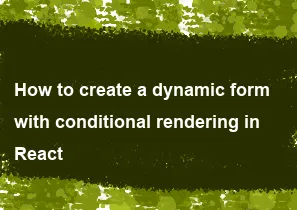How to create a dynamic form with conditional rendering in React

Creating a dynamic form with conditional rendering in React involves using state to track the form's input values and conditions, as well as rendering different form fields based on certain conditions. Here's a basic example:
jsximport React, { useState } from 'react';
const DynamicForm = () => {
const [formData, setFormData] = useState({
firstName: '',
lastName: '',
isEmployed: false,
jobTitle: '',
});
const handleChange = (e) => {
const { name, value, type, checked } = e.target;
setFormData(prevState => ({
...prevState,
[name]: type === 'checkbox' ? checked : value
}));
};
return (
<form>
<label>
First Name:
<input
type="text"
name="firstName"
value={formData.firstName}
onChange={handleChange}
/>
</label>
<label>
Last Name:
<input
type="text"
name="lastName"
value={formData.lastName}
onChange={handleChange}
/>
</label>
<label>
Employed:
<input
type="checkbox"
name="isEmployed"
checked={formData.isEmployed}
onChange={handleChange}
/>
</label>
{formData.isEmployed && (
<label>
Job Title:
<input
type="text"
name="jobTitle"
value={formData.jobTitle}
onChange={handleChange}
/>
</label>
)}
<button type="submit">Submit</button>
</form>
);
};
export default DynamicForm;
In this example, the form contains fields for first name, last name, an employment status checkbox, and a job title input field. The job title field is conditionally rendered based on the value of the isEmployed state. When the checkbox is checked, the job title field appears; otherwise, it's hidden.
This demonstrates how you can create a dynamic form with conditional rendering in React. Depending on your specific requirements, you can extend this pattern to include more complex conditions and form fields.
-
Popular Post
- How to optimize for Google's About This Result feature for local businesses
- How to implement multi-language support in an Express.js application
- How to handle and optimize for changes in mobile search behavior
- How to handle CORS in a Node.js application
- How to use Vue.js with a UI framework (e.g., Vuetify, Element UI)
- How to configure Laravel Telescope for monitoring and profiling API requests
- How to create a command-line tool using the Commander.js library in Node.js
- How to implement code splitting in a React.js application
- How to use the AWS SDK for Node.js to interact with various AWS services
- How to use the Node.js Stream API for efficient data processing
- How to implement a cookie parser middleware in Node.js
- How to implement WebSockets for real-time communication in React
-
Latest Post
- How to implement a dynamic form with dynamic field styling based on user input in Next.js
- How to create a custom hook for handling user interactions with the browser's device motion in Next.js
- How to create a custom hook for handling user interactions with the browser's battery status in Next.js
- How to implement a dynamic form with dynamic field visibility based on user input in Next.js
- How to implement a dynamic form with real-time collaboration features in Next.js
- How to create a custom hook for handling user interactions with the browser's media devices in Next.js
- How to use the useSWRInfinite hook for paginating data with a custom loading indicator in Next.js
- How to create a custom hook for handling user interactions with the browser's network status in Next.js
- How to create a custom hook for handling user interactions with the browser's location in Next.js
- How to implement a dynamic form with multi-language support in Next.js
- How to create a custom hook for handling user interactions with the browser's ambient light sensor in Next.js
- How to use the useHover hook for creating interactive image zoom effects in Next.js